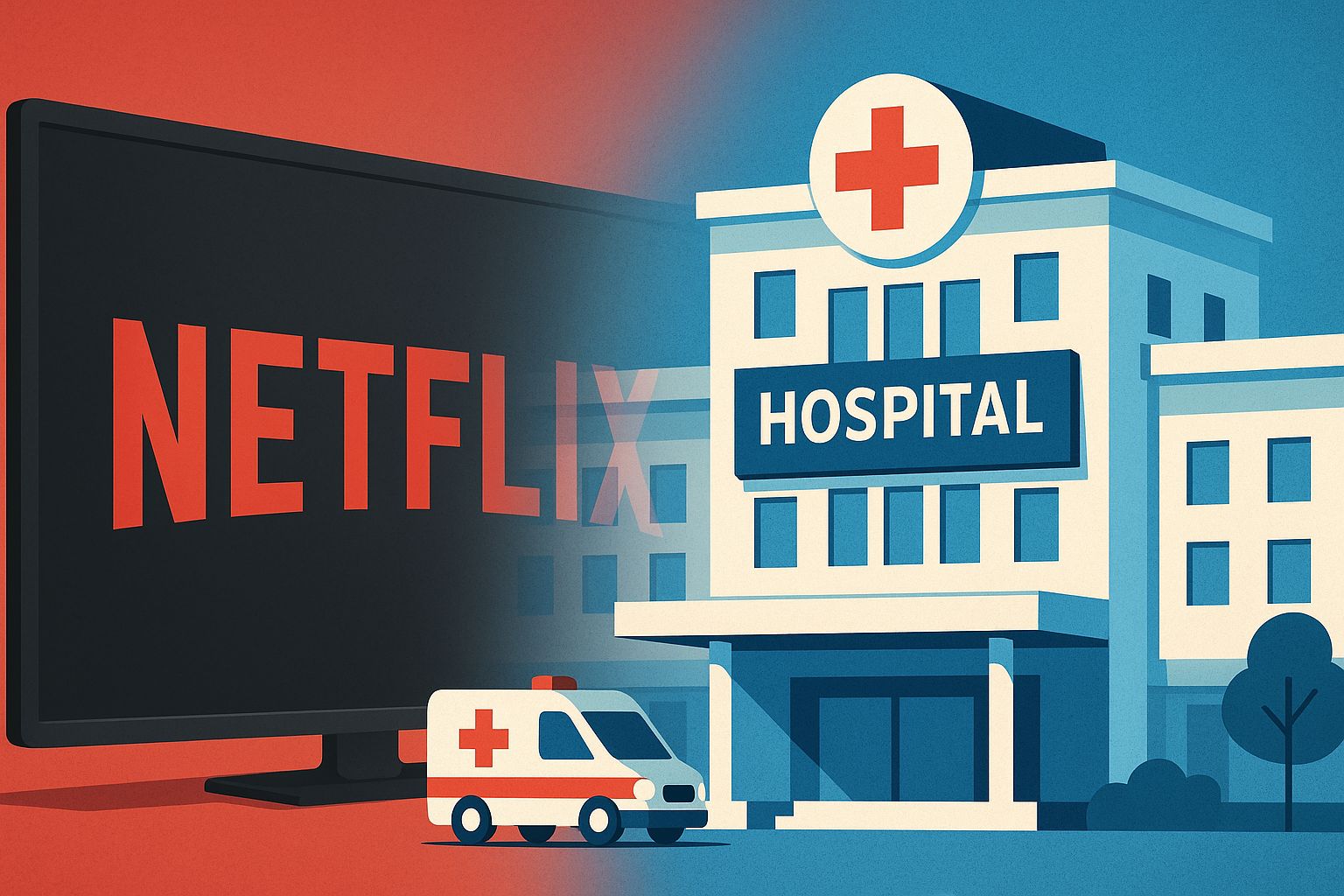- The Healthcare Syndicate
- Posts
- Hospital at Home, Part I: The Counterintuitive Netflix Playbook for Virtual Care
Hospital at Home, Part I: The Counterintuitive Netflix Playbook for Virtual Care
Why early investors should double down on physical partnerships first.

Netflix didn’t begin as a tech company.
It was a logistics company mailing DVDs.
In 2000, that felt more like a novelty than a revolution. Why bother with Netflix when there was a Blockbuster around every corner?
But Netflix understood something Blockbuster didn’t: people didn’t want the store. They wanted the movie.
Today, the Hospital at Home movement sits in the same place Netflix once did—awkward, underestimated, and far from mainstream. Hospitals know care is shifting outward. Patients like the idea. But adoption is slow, and most see it as a side experiment, not the future.
To see how it might scale, it’s worth remembering how Netflix moved from “interesting” to “inevitable.”
🚀 Turn Insights into Investing Action 🚀
Staying ahead in healthcare investing means understanding where the real opportunities lie. Our dealflow newsletter curates high-potential early-stage healthcare companies, helping investors act early on trends like the opportunities in healthcare AI we are sharing here. Subscribe today to discover the companies solving the biggest challenges in healthcare - right before the big name funds get involved.
Policy Wants Care Out of the Hospital
Hospitals aren’t fighting to keep people inside. They’re being pushed to get them out.
A few drivers:
Readmission penalties. CMS’s Hospital Readmissions Reduction Program cuts payments for avoidable readmissions, making home-based follow-up valuable.
Medicare Advantage and managed care. These plans restrict inpatient authorizations and often reimburse home-based recovery.
Bundled and ACO models. Tying payment to outcomes instead of volume makes shorter stays more profitable.
The CMS Hospital at Home waiver. Launched during COVID, it showed some “inpatient” cases could be treated safely—and reimbursed—at home.
Incentives are lining up, but why is adoption lagging?
Why Adoption Lags
Even with aligned policy, most health systems haven’t scaled Hospital at Home.
Why? Because the hospitals of today were designed for the physical world only:
Hospitals are built for beds, not homes. Staffing, billing, and workflows all center around inpatient infrastructure. Decentralizing care means new teams, tools, and metrics.
Fragmented tech. Remote vitals, scheduling, and escalation all run on separate systems. Coordination is clunky and riskier.
Clinician reluctance. Doctors and nurses aren’t trained—or compensated—to act as mobile teams. Liability and unfamiliar workflows slow buy-in.
Patient hesitation. Many still associate safety with a physical hospital, despite high satisfaction when Hospital at Home is done well.
The challenge isn’t interest. It’s infrastructure, trust, and behavior.
So the question becomes: how do startups and hospitals actually make this shift work?
The Netflix Lesson
Netflix didn’t scale by telling people to abandon Blockbuster and go fully online.
Mail-order DVDs alone would have capped its growth.
To speed adoption, Netflix leaned into physical partnerships:
In 2001, it partnered with Best Buy, giving Netflix in-store visibility and mainstream credibility.
It added drop-off and return options at retail locations and mailing centers. This sped up service and reduced issues like lost discs or delivery delays.
These moves built trust and scale, accelerating Netflix’s subscriber base until streaming was ready for prime time.
If Netflix had stayed purely virtual, it likely would’ve stayed niche—easily overtaken by Blockbuster’s own mail program or by kiosks like Redbox.
The key takeaway? The bridge years mattered. Physical infrastructure wasn’t a detour. It was the on-ramp.
Hospital at Home startups should take note:
Partner with hospitals, don’t bypass them. Start with post-discharge and partial-episode programs before replacing full admissions.
Use hybrid infrastructure. Infusion centers, local monitoring hubs, and shared logistics networks can make at-home care more reliable and trusted.
Integrate with existing systems. Build tools that work with hospital workflows and EHRs, not against them.
In healthcare, reimbursement and relationships still run through incumbents. And just like studios and retailers had reasons to work with Netflix, hospitals have their own reasons to welcome these partnerships.
Why Hospitals Will Say Yes
Netflix’s partnerships worked because studios and retailers saw value:
They reached customers Blockbuster wasn’t serving.
They got guaranteed revenue from licensing fees.
They gained insights into what audiences actually wanted.
Hospitals have similar incentives to work with Hospital at Home startups:
Protect patient volume. Every patient kept in-network brings downstream revenue—labs, imaging, procedures—that would otherwise leak out. Hospitals estimate that reducing patient leakage can boost overall revenue by about 17%, so keeping patients in-network would provide significant revenue lift.
Capture care they’d otherwise lose. Some patients don’t meet inpatient criteria or get denied by payers; a home program brings that revenue back inside.
Look good to payers. Hospitals that lower readmissions and total cost of care gain leverage in value-based contracts and shared savings.
Build patient loyalty. Home-based care improves satisfaction scores, making patients more likely to return for future needs.
That makes partnerships not just tolerated, but actively welcomed, especially if the program helps protect the hospital’s bottom line.

Why Startups Can Do More Than Just Help
But that doesn’t mean this is destined to become a hospital-only feature.
Even with partnerships, there’s a real opening for startups to build lasting businesses.
Startups have three advantages that make this more than just a feature destined for rollup:
They’re built for mobile care. Hospitals are optimized for filling fixed assets—beds, ORs, clinics—not running fleets of clinicians and logistics networks. Startups can design for decentralized care from the start.
They can scale across systems. A single hospital can only serve its own patients. A neutral startup can aggregate demand across multiple hospitals, payers, and geographies, creating economies of scale in staffing, logistics, and tech.
Neutral player among competing health systems: Not every health system wants to rely on a competitor’s in-house Hospital at Home program. Neutral third parties can serve multiple systems without threatening any one hospital’s turf.
For investors, that means the companies that thrive here won’t just be contractors.
They’ll be neutral, scalable infrastructure, indispensable to hospitals before the full shift to virtual care arrives.
What This Means for Investors
As a smaller check angel investor, we aren’t likely to fund companies pursuing strategies that require massive amounts of capital like General Catalyst buying a whole health system and creating a new world from scratch.
In order to compete, we need to invest in underappreciated and high-leverage opportunities that will yield outsized returns.
For Hospital at Home, We’re not getting to decentralized, fully virtual healthcare in one leap. The winners in this market will be the startups that build those bridges:
Creating partnerships with health systems rather than trying to replace them.
Using hybrid infrastructure to reduce friction and build trust.
Aligning with how money flows today while setting themselves up for the care models of tomorrow.
For early-stage investors, spotting these transitional plays is where the best investing outcomes come from.

Netflix didn’t just scale by mailing DVDs or even streaming faster than everyone else. Its real moat came when it started creating original content—programming designed for the audience it had built, not just rented from others.
We’ll cover exactly how Hospital and Home startups can leverage this strategy in Part 2. Sign up for our newsletter so you don’t miss it.
Join us at The Healthcare Syndicate as we back the most ambitious founders 10Xing the standard of healthcare!
Reply